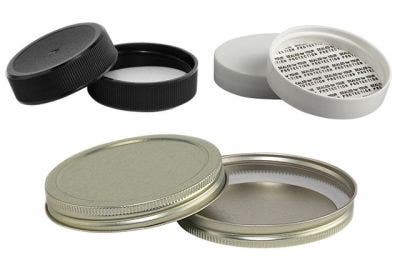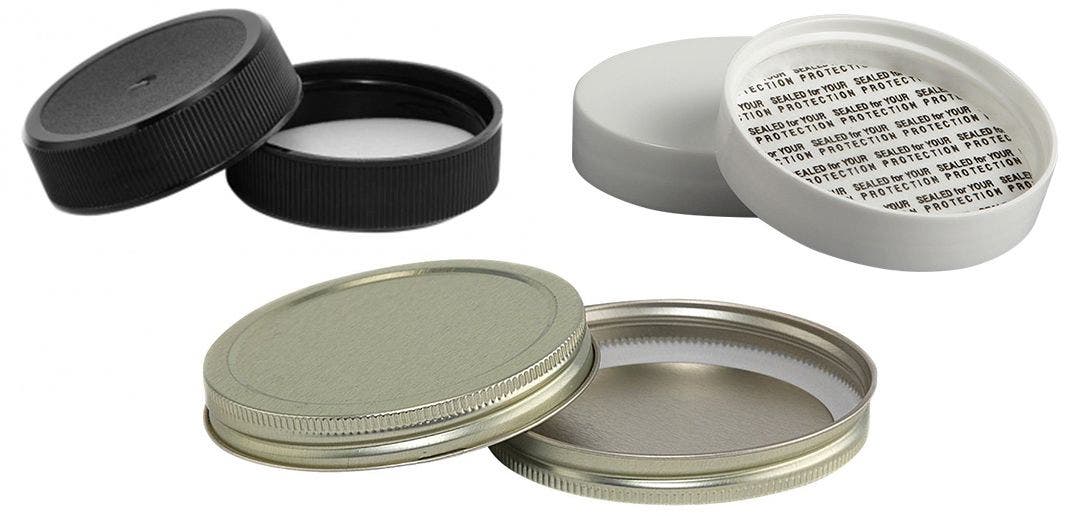A Guide to Different Cap Liner Types & Functions 
F-217 Foam Liner
The 3-ply foam liners consist of three layers, where a thin foam core is enclosed between two layers of LDPE film. While F217 is a brand name commonly used interchangeably with foam liners, it outperforms regular foam liners. Unlike the foam liner, it does not form an airtight seal.
Used For:
It possesses taste and odor resistance and exhibits a low moisture transmission rate, preventing moisture from entering the bottle and affecting the product.
- Household
- Cosmetic
- Liquor
- Food
- Water-based products
Pressure Sensitive Liner (PS-22)
Structurally akin to a foam liner, pressure-sensitive liners feature adhesive on one side, intended to adhere to the rim of a container. Upon closure of the container and application of pressure to the cap (and subsequently the liner), the adhesive activates, creating a seal.
Used For:
Pressure-sensitive liners provide an additional layer of protection by forming a seal adhering to the bottle's rim. Note that pressure seals are not considered tamper-evident. They are not suitable for liquids, particularly oils, but can be effective with thick liquids like creams and sauces.
- Dry products
- Dry food/powders
- Thick liquids
Pulp and Poly Liner
Pulp and poly liners comprise two components: a thin polyvinyl film attached to a pulp material.
Used For:
Pulp and poly liners exhibit good chemical resistance, working well with both oil and water-based products. They are incompatible with bleach or active hydrocarbons but perform effectively with inert (low acid) products.
- Cold fill applications
- Mild acids
- Alcohol
- Powders
Plastisol Liner
A plastisol liner is distinctive as it is integrated into a cap. A plastic gasket lines a metal cap, forming an airtight seal when heated and cooled.
Used For:
Plastisol-lined caps are ideal for high-temperature applications, requiring containers capable of withstanding high temperatures to achieve a vacuum seal. They are typically acid-resistant.
- Canning
- Hot-fill items like sauces and preserves
Foam Liner
The foam liner is a versatile option made of compressible polyethylene foam. While it does not create a seal, it is commonly used for leak prevention.
Used For:
Foam liners are compatible with various substances, offering an economical choice. They can also be employed to fill the space on top of the cap when the neck thread is not sufficiently high for a tight closure.
- General Purpose
- Household
- Water-based products
HS 035
HS 035 consists of a paper-backed aluminum foil coated with a clear heat-sealable blend of high molecular weight ethylene and vinyl acetate copolymers. It is aluminum in color.
Used For:
Suggested uses include serving as a tamper-indicating inner seal for OTC drug products on PE, glass, PET, PVC, PS, and PP containers.
- Dry Products
- Spices
- Fruit Juice
- Milk
- Glass Cleaner
- Peroxide
SFYP
When pressure-sensitive or heat induction liners bear the imprint "SEALED FOR YOUR PROTECTION."
FoilSeal M-1
It adheres to PE containers through a welded bond and, with a pulp backing, provides a tamper-evident seal for pharmaceutical, anti-freeze, and windshield solvent applications.
PS-113
A PS-113 liner is a one piece polystyrene foam coated on one side with a specially formulated torque-activated adhesive. It will effectively seal to glass and plastic containers. It will not provide the consumer an indication of tampering (tamper evidency).
It is not approved for wet products.
MRPLN04
MRPLN04 is a universal heat seal consisting of foam backing, paper, aluminum foil and heat seal layer.
Once you've determined the right type of liner for you, we have many shoppable items available at TricorBraun. Please contact our customer service team for samples. We do not guarantee certain items for any specific use and recommend testing samples prior to purchasing. If you have any questions, reach out to one of our packaging consultants.
TALK TO A PACKAGING CONSULTANT
Whether you’re looking for a stock package or a groundbreaking custom design, TricorBraun’s proven process will guide your packaging decisions from napkin sketch all the way to the retail shelf.




